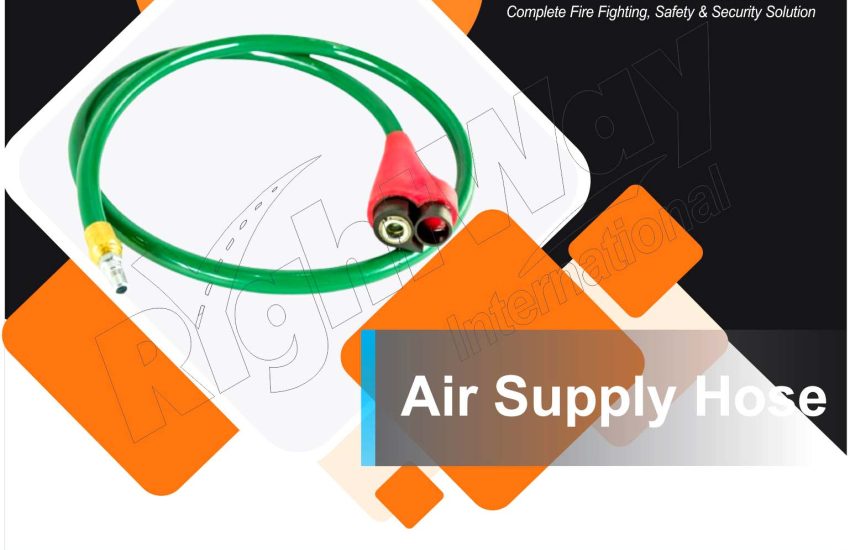Air Supply Hose plays a vital role in respiratory protection systems such as Self-Contained Breathing Apparatus (SCBA) and airline breathing units. It serves as the critical connection between the air source and the respirator or mask, ensuring a steady flow of clean air in hazardous environments.
1. Purpose and Importance
The primary purpose of the air supply hose is to deliver filtered, breathable air from an external source directly to the user’s respiratory protection system. This function becomes especially important in situations where the air may contain harmful substances. Common use cases include:
- Industrial Settings: Factories, refineries, and chemical plants where toxic fumes may be present.
- Emergency Response: Firefighting, hazardous material handling, and rescue operations.
- Confined Spaces: Poorly ventilated areas where contaminants can accumulate quickly.
By maintaining a constant air supply, the hose protects workers from inhaling dangerous pollutants.
2. Key Components of the Air Supply Hose
Each air supply hose is made of carefully engineered components that work together to provide durability, safety, and performance.
Hose Material
Manufacturers use materials such as rubber, polyurethane, or nylon to ensure flexibility and resistance to abrasion, chemicals, and heat. As a result, the hose can endure rough handling and exposure to harsh conditions.
Inner Liner
The inner liner creates a smooth, clean passage for air, preventing contamination and preserving air quality.
Reinforcement Layer
To withstand pressure and prevent kinks, hoses often include reinforcements made from steel or synthetic fibers. This added strength is especially useful in dynamic work environments.
Connectors
Connectors ensure a secure link between the hose and equipment:
- Quick-Connect Fittings: Allow users to attach or detach the hose quickly during emergencies.
- Threaded Connectors: Provide a secure, leak-proof connection that won’t come loose unintentionally.
Together, these components help maintain a reliable and secure air delivery system.
3. Types of Air Supply Hoses
Air supply hoses vary by design and pressure capability, allowing users to choose the right type for their specific needs:
- Flexible Hoses: Provide excellent mobility, making them ideal for dynamic or awkward working positions.
- High-Pressure Hoses: Deliver air from SCBA cylinders and can withstand high internal pressures.
- Low-Pressure Hoses: Work with airline systems that operate at lower, regulated air pressures.
- Coiled Hoses: Help prevent tangling and save space when stored, while still offering flexibility during use.
By understanding the differences between hose types, users can select the most suitable option for their application.
4. Applications
Due to their versatility, air supply hoses are used across a wide range of industries:
- Industrial Safety: Provide workers with clean air in areas with chemical exposure or poor ventilation.
- Firefighting: Allow firefighters to breathe safely while navigating smoke-filled or toxic environments.
- Emergency Services: Help responders stay protected during disaster relief and rescue operations.
- Diving: Surface-supplied systems use these hoses to deliver air to divers working below water.
In each scenario, the hose plays a critical role in preserving life and enhancing safety.
5. Maintenance and Care
To keep air supply hoses in peak working condition, users should follow a consistent maintenance routine:
- Inspect Regularly: Look for signs of damage, leaks, or wear. Confirm that all connectors remain secure and functional.
- Clean Properly: Follow the manufacturer’s recommendations and use only compatible cleaning products to avoid material degradation.
- Store Correctly: Keep hoses in a clean, dry environment away from sunlight or extreme temperatures to prevent material fatigue.
- Replace When Needed: Don’t hesitate to replace a hose if it shows serious wear or if its performance declines.
By practicing proper care, users can extend the hose’s lifespan and avoid unexpected failures.
6. Safety Considerations
Ensuring safety when using air supply hoses involves several important practices:
- Secure Connections: Always double-check that the hose is fully connected to both the respirator and the air source.
- Avoid Kinks and Twists: Improper hose placement can restrict airflow or cause long-term damage.
- Train Users: Make sure all personnel are trained to properly use, inspect, and maintain the hose.
With proper attention and training, users can avoid common risks and ensure reliable operation.
7. Regulatory Compliance
To guarantee safety and performance, air supply hoses must comply with established industry standards:
- OSHA (Occupational Safety and Health Administration)
- NIOSH (National Institute for Occupational Safety and Health)
- CEN (European Committee for Standardization)
- ANSI (American National Standards Institute)
Following these standards ensures that hoses meet rigorous quality, performance, and safety requirements.
Conclusion
The Air Supply Hose is an indispensable part of any respiratory protection system. By understanding its components, types, applications, and care guidelines, users can ensure a reliable flow of clean air in high-risk environments. Ultimately, regular maintenance, proper training, and compliance with safety standards are key to protecting both the equipment and the people who depend on it.


